![]()
![]()
![]()
Use LEFT and RIGHT arrow keys to navigate between flashcards;
Use UP and DOWN arrow keys to flip the card;
H to show hint;
A reads text to speech;
93 Cards in this Set
- Front
- Back
- 3rd side (hint)
|
Pituitary starts here
|
Pituitary starts here
|
|
|
|
Briefly, what 3 categories of pituitary pathology occur? (this is a broad overview question)
|
Developmental disorders
- aplasia, hypoplasia - - - - inherited, toxic, infectious - pituitary cysts Inflammation - systemic D or extension from face/orbit Neoplasia - non-functional or functional adenomas - others |
|
|
|
What is the typical concentration of hormones in the blood?
How does this compare with other chemicals? |
Typically 10-10 -> 10-11 for hormones
compared to 10-3 - 10-5 for others Hormones are active at these concentrations due to high affinity receptors |
|
|
|
There are 3 types of cells in the pituitary.
Name them, the different cell types in each category and the products of each |
Acidophils
- somatotrophs - GH* - luteotrophs - prolactin Basophils - gonadotrophs - LH, FSH - thyrotrophs - TSH Chromophobes (don't stain) - corticotrophs - ACTH* - melanotrophs - MSH |
|
|
|
Sketch and briefly discuss the regulation of pituitary hormones
|
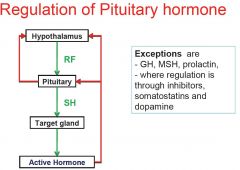
Now, write in the RF and SH for corticosteroids
|
|
|
|
Where is the pituitary. What structures is a space occupying lesion likely to effect?
|
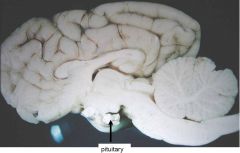
The pituitary lies in a bony depression at the base of the brain (sella turcica).
Enlargement of the pituitary is likely to effect the hypothalamus and optic chiasm. |
|
|
|
Failure of pituitary development
- what 3 mechanisms are most common? |
Genetic: aplasia -> prologoned gestation in several cattle breeds
Toxicities in utero: hypoplasia -> Veratrum californicum in ewes Infectious in utero: viral |
|
|
|
How does Veratrum californicum lead to developmental disorders of ewes?
(I don't think this is v-imp but the process of pathogenesis is an interesting exercise that can be applied to any damage of the hypothalamus) |
Exposure to skunk cabbage between d9-14 of gestation inhibits neural tube formation.
Absent/malformed hypothalamus -> lack of releasing factors from hypo -> lack of stimulating H from pit -> target organ hypoplasia -> CS |
|
|
|
Discuss the aetiology & pathogenesis of pituitary dwarfism
|
Inherited in several dog breeds (esp GSD)
Pituitary cyst formation Clinically progressive: GH> TSH but ACTH generally not affected CS: proportional dwarfism, cretinism, puppy coat retained |
|
|
|
Do pituitary cysts always lead to pituitary dwarfism?
|
No, they can be incidental findings
|
|
|
|
What are the two general mechanisms for pituitary inflammation?
|
1. Systemic inflammatory diseases
2. Local extension from face or nose dt bacterial or mycotic infection |
|
|
|
Pituitary adenomas are classified in two ways.
What are they? |
Non-functional - hormonally inactive
Functional - hormonally active |
|
|
|
Briefly, what are 5 potential consequences of a non-functional pituitary adenoma?
Why do they occur? |
Clinical signs dt
- functional loss of pituitary, and/or - compression of adjacent tissues Potential consequences - adult onset panhypopituitarism dt decr. secretion of trophic hormones) - pituitary cachexia dt loss of protein anabolic effects of GH - blindness dt compression of optic nerves or optic chiasm - diabetes insipidus dt effect on posterior pituitary - CNS dysfunction dt effects on hypothalamus |
|
|
|
List the 3 most common functional tumours, the cells & species affected.
|
Chromophobe adenoma in dogs -> pituitary dependent Cushings
Chromophobe adenoma in horses -> CS referable to hypothalamic compression, occ. pit-dep Cushings Acidophils tumours in cats -> excess GH -> acromegaly |
|
|
|
Chromophobe adenoma in dogs
- cause - breeds - clinical signs |
PItuitary dependent Cushings
- excess ACTH -> excess cortisol - Boxers, Terriers, Dachshunds - bilateral enlargement of adrenal glands - PUPD, thin skin, obesity, pot belly, alopecia, may progress to DM |
|
|
|
How is chromophobe adenoma of horses different to dogs?
|
CS usually dt hypothalamic derangement. If functional, MSH, endorphins in excess NOT ACTH.
Striking feature is hairiness |
|
|
|
Acromegaly is dogs occurs via a different mechanism to that most commonly seen in cats. Discuss
|
In dogs, acromegaly is associated with excess progestin exposure.
This triggers hyperplasia of the mammary gland and excess GH In cats, acromegaly is usually dt a functional pituitary adenoma affecting the somatotrophs (GH) |
|
|
|
List 5 common CS of acromegaly
|
1. Thickened CT -> heavy facial features
2. Thickened bones, subcutis, visceral enlargement 3. Insulin dependent DM 4. PUPD 5. Large body mass |
|
|
|
What are the two main mechanisms leading to diabetes insipidus?
|
1. Central - defect in posterior pituitary leading to decr. ADH
2. Peripheral aka "nephrogenic DI" - defect in kidneys leading to decr response to ADH |
|
|
|
What is the key diagnostic feature of central diabetes insipidus?
|
Polyuria in the abscence of renal disease
|
|
|
|
Central diabetes insipidus can be dt lesions in hypothalamus or the posterior pituitary. Why?
|
Remember that the posterior pituitary is neural tissue. The hormones ADH and oxytocin and made in the large & small nuclei of the hypothalamus and transported to the post-pit.
|
|
|
|
List 8 effects of hypothalamic destruction
|
PUPD
hirsuitism altered appetitie insulin resistant hyperglycaemia weakness incoordination, tremors somnolences blindness hyperhidrosis (sweating) aggression/mood swings |
|
|
|
Now, write a summary of the endocrine pathology of the pituitary gland - mechanisms, conditions, species most affected
|
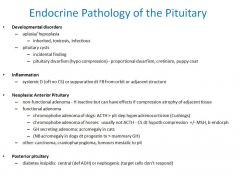
|
|
|
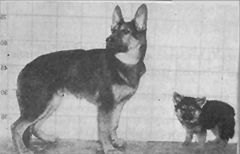
These are litter mates.
What is the aetiology and pathogenesis? |

Pituitary hypoplasia dt pituitary cyst
Progressive loss: GH> MSH (ACTH rarely affected) Inherited disorder in several dog breeds incl GSD |
|
|
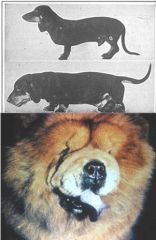
What is the aetiology & pathogenesis?
|

Acromegaly in dogs. Usually dt excessive progestin exposure > mammary hyperplasia > excessive GH
Overall enlargement of soft & bony tissues seen as increased mass and facial thickenings |
|
|
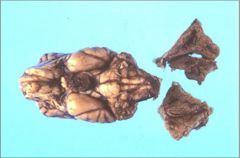
What is this image suggesting?
|

Functional pituitary adenoma (chromotroph = corticotrophs) -> excess ACTH -> bilateral hyperadrenocortisim.
This animal most likely showed clinical signs of pituitary dependent hyperadrenocorticism (Cushings) |
|
|
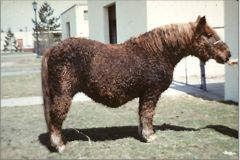
What is wrong with this horse? (It shouldn't be this hairy)
|

Most likely pituitary chromophobe adenoma. In horses, effects are dt hypothalamic derangement. If functional, MSH & endorphins most likely affected. Unlike dogs, ACTH not usually affected
|
|
|
|
Thyroid starts here
|
Thyroid starts here
|
|
|
|
Thyroid:
what are the 3 categories of dysfunction for the thyroid |
Hypothryoidism
Hyperthyroidism Neoplasia |
|
|
|
What are the two broad mechanisms by which hypothryoidism may occur?
|
Decreased functional thyroid mass
Ineffective thyroid hormone production |
|
|
|
Hyperthyroidism is most commonly seen in which species?
How does this usually arise? |
Cats, esp. > 8 yo
Functional hyperplasia or adenomas |
|
|
|
In which species are thryoid carcinomas commonly seen?
What are the usually sequelae? |
Dogs, predisposition for beagles, boxers, goldies
Compression effects, metastasis to lung, 10% are functional |
|
|
|
Hypothyroidism dt decreased functional mass;
give 5 mechanisms by which this might occur? Which are the two most common mechanisms in dogs? |
lymphocytic thyroiditis (auto-immune = Hashimotos) **** dogs
idiopathic follicular atrophy **** dogs aplasia/ hypoplasia neoplasia (causing destruction) secondary to pituitary damage (decr. TSH) |
|
|
|
Hypothyroidism can also occur dt ineffective thyroid hormone production.
What is this called? What forms can it take? Give three causes |
Goitre - diffuse, colloid, nodular
I deficiency I excess goitrogenic compounds |
|
|
|
What are the two main types of thyroid neoplasia?
What are the most common effects of each? |
Thyroid adenoma - benign
Thyroid carcinoma - compression effects, metastases to lung, 10% functional |
|
|
|
Define adenoma
|
A benign epithelial tumour in which the cells form recognisable glandular structures
or in which the cells are derived from glandular epithelium |
|
|
|
Define carcinoma
|
Malignant new growth made up of epithelial cells tending to infiltrate surrounding tissues and to give rise to metastases.
|
|
|
|
Create a summary of endocrine pathology of the thyroid gland
|
Well done! (add pic)
|
|
|
|
What are the products of the thyroid gland?
|
T3 & T4 from thyroid epithelial cells
Calcitonin from the parafollicular C cells |
|
|
|
List 4 main functions of T3 & T4
|
Increases BMR
Increases synthesis & catabolism Acts with GH in musculoskeletal & NS development in young animals Increases HR, CO |
|
|
|
List 6 clinical signs of hypothyroidism in dogs
|
Decreased BMR, lethargy, dullness, inactivity
cretinism in neonates & juvenilles rat-tail, dry hair coat symmetrical alopecia seborrhoea myxoedema "tragic facial expression" Peripheral neuropathies, myopathies Reproductive failure in females |
|
|
|
What are the two main causes of hypothyroidism in dogs?
|
Lymphocytic thyroiditis (Hasimoto's)
- inherited autoimmune Idiopathic follicular atrophy |
|
|
|
List 3 other causes of hypothyroidism
|
Hypoplasia/aplasia
Atrophy Destruction dt neoplasia Sx removal Secondary to pituitary disease Ineffective production (conditions leading to goitre) |
|
|
|
What is goitre?
How is it manifest differently in cats? |
Non-neoplastic, non-inflammatory thyroid enlargement
TYPICALLY associated with HYPOTHYROIDISM Associated with hyperthryoidism in cats |
|
|
|
What are the 3 forms of goitre?
|
Diffuse (hyperplastic)
Nodular Colloid |
|
|
|
What situations lead to goitre?
|
Iodine deficiency
Iodine excess Exposure to goitrogens |
|
|
|
How is it that iodine excess can lead to goitre?
|
Inhibits iodide uptake by thryoid gland
Low T3, T4 TSH secretion continues Hyperplasia of epithelial cells without functional hormone production |
|
|
|
What is linked to the increased incidence of hyperthryoidism in cats over the last 40 years
|
Tinned cat food and excess iodine in diet
|
|
|
|
What clinical signs are associated with feline hyperthryoidism (give 6)
|
Weight loss
Polyphagia PUPD Alopecia Scurfy appearance Tachycardia Hyperactivity, nervousness, aggression |
|
|
|
Name 2 potentially devastating sequelae of hyperthyroidism in cats
|
Left ventricular concentric myocardial hypertrophy dt system hypertension
Retinal aneurysm or detachment dt systemic hypertension |
|
|
|
In what species is C cells hyperplasia & neoplasia most common?
What is the outcome? |
Horse - C cell adenomas common in older animals
Often non-functional and incidental finding |
|
|
|
Now, write a summary of the endocrine pathology of the thyroid gland - mechanisms, conditions, species most affected
|
add pic here
|
|
|
|
Parathyroid starts here
|
Parathyroid starts here
|
|
|
|
List actions of parathyroid hormone at three main sites
|
PTH is released in response to low plasma Ca
PTH has roles in Ca homeostasis & in the calcification of bone 1. Bone: incr osteoclast activity & osteoblast no. 2. Kidney: activation of VitD, incr absorption of Ca in proximal tubules 3.Gut: incr Ca absorption (dt VitD activation) |
|
|
|
Which is seen more commonly - hypoparathyroidism or hyperparathyroidism
|
HYPERparathyroidism
|
|
|
|
What are the causes of hypoparathyroidism?
|
Primary:
- autoimmune -> decr. PTH Secondary - neoplasia - hypoplasia - atrophy following sustained HYPERcalcaemai - gland destruction (eg sx) |
|
|
|
What's milk fever got to do with any of this?
|
Acute hypocalcaemia at parturition usually following a period of high Ca during preg (PTH atrophy) and then low Ca at parturition -> PT unable to respond appropriately
Barely mentioned by Ron but included here for completeness |
|
|
|
List the primary & secondary causes of hyperparathyroidism
|
Primary: functional tumour or hyperplasia -> excess PTH
Secondary - nutritional - renal - paraneoplastic |
|
|
|
What are the causes & effects of hyperparathyroidims in dogs and horses?
|
For both species -> secondary hyperparathyroidism -> fibrous osteodystrophy = excessive fibrous material in bone esp facial. Also see calcification of soft tissues
Dogs: renal secondary hyperparathryoidism Horses: nutritional secondary hyperparathyroidism |
|
|
|
Now, write a summary of the endocrine pathology of the parathyroid gland - mechanisms, conditions, species most affected
|
add pic here
|
|
|
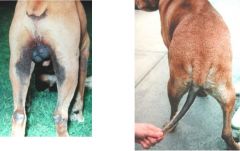
Discuss likely aetiology & pathogenesis for this dog?
|

|
|
|
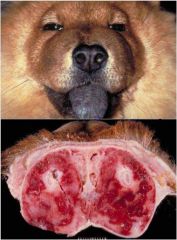
What's the likely aetiology & pathogeneis for this dog?
|

Fibrous osteodystrophy dt secondary renal hyperparathyroidism
|
|
|

What's the likely aetiology & pathogeneis for this horse?
|

Fibrous osteodystrophy dt secondary nutritional hyperparathyroidism
|
|
|
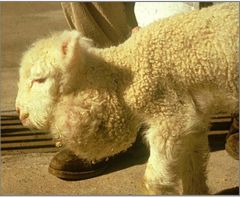
What's the likely aetiology & pathogeneis for this sheep?
|

Hyperplastic goitre possible dt
- mother grazing pasture with insufficient iodine - mother grazing pasture with plants containing goitrogens |
|
|
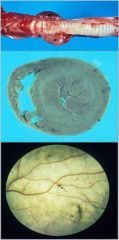
Samples form a scurfy cat. What's being shown here?
|

For extra points, explain how systemic hypertension leads to LV concentric myocardial hypertrophy
|
systemic HT -> incr. BP -> incr. P against which left heart contracts -> incr. work of LV -> concentric myocardial hypertrophy (response to chronic P overload)
|
|

Histology of various thyroids. What's being shown here?
|

|
|
|
|
Adrenals start here
|
Adrenals start here
|
|
|
|
3 zones of adrenal cortex & products
|
?
|
|
|
|
Main functions of adrenal cortex products
|
?
|
|
|
|
List 3 developmental anomalies of the adrenal gland
|
Agenesis: unilateral or bilateral (-> death)
Hypoplasia dt hypothalamus or pituitary deficit Accessory adrenal tissue |
|
|
|
List 3 degenerative lesions of the adrenal gland
|
Mineralisation
Amyloidosis (both oft incidental) Haemorrhage |
|
|
|
What situations can lead to adrenocortical haemorrhage?
|
DIC
Shock Septicaemias Neonates: hypoxia, birth trauma, cold stress |
|
|
|
What are the 2 mechanisms for enlargement of the adrenal glands?
|
Hyperplasia
Neoplasia |
|
|
|
List the 5 types of hyperplasia of the adrenal cortex
|
Accessory nodules
Nodular Diffuse cortical Hyperplasia of the zona glomerulosa -> hyperaldosteronism - primary (idiopathic) - secondary (dt renal D, hypoT, Na depletion) |
|
|
|
What are the two types of adrenal cortical neoplasia?
What are the usual sequelae? |
Adenomas:
- common, usually non-functional Carcinomas: - often invasive (aorta, VC) and metastasize, - usually non-functional A small no. can be functional leading to adrenal dependent hyperadrenocorticism (Cushings) |
|
|
|
What are the 3 main causes of hyperadrenocorticism (Cushings)?
- proportion? - uni/bilateral? - breeds affected? |
Pituitary-dependent
- 85% in dogs - bilateral - small breed Adreno-dependent - 15% - usually unilateral - med-large breeds Iatrogenic - excess exogenous cortisol |
|
|
|
List 12 clinical signs of hyperadrenocorticism in dogs
Make sure you can sketch a brief pathogenesis for each |
PUPD
polyphagia enlarged abdomen thin skin calcinosis cutis delayed wound healing hepatomegaly DM Muscle weakness Endocrine dermatosis Secondary infections Lethargy Wasting |
|
|
|
How does diabetes mellitus develop in response to hyperadrenocorticism?
|
Cortisol antagonises insulin leading to the development of insulin resistance, hyperglycaemia and eventually DM
Note: the most common clinical signs in dogs/cats when concurrent disease presents are referable to the DM: PUPD, polyphagia with weight loss |
|
|
|
List 3 key points about hyperadrenocorticism in cats
|
Rare
Most dt functional pituitary tumour (95%) Mostly old cats (> 10y) |
|
|
|
List the 4 types of hypoadrenocorticism
|
Primary (Addisons)
Secondary to pit/hypo deficits Iatrogenic (mitotane tx for hyperA) Idiopathic |
|
|
|
What is a phaeochromocytoma and why should you care?
|
Phaeochromocytoma = "dusky coloured cell tumour"
Tumour of the adrenal medulla (most common, esp dogs, cattle) Tan/brown often with haemorrhage Invasion of vena cava with tracking to the heart is common with malignancies |
|
|
|
What's typical of phaeochromocytomas in bulls?
|
Develop concurrently with calcitonin C-cell tumours of the thyroid gland (same embryological origin)
|
|
|
|
Now, write a summary of the endocrine pathology of the adrenal gland - mechanisms, conditions, species most affected
|
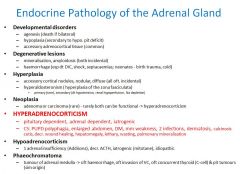
|
|
|
|
Pancreas starts here
|
Pancreas starts here
|
|
|
|
There's only really one tumour of the pancreas that you NTK now.
What is it? Who gets it? What effects does it have? |
Insulinomas (beta-cells of the pancreas)
Middle aged - older dogs esp GSD, fox terriers, standard poodles, boxers, irish setters Effects mostly referable to glucose depletion: episodic seizures, weakness, collapse |
|
|
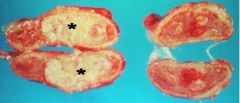
Transected adrenals from small white fluffy dog with thin skin and pot-belly. What's the likely aetiology & pathogenesis?
|

Unilateral adrenals thus adrenal-dependent hyperadrenocorticism (hyperA) dt functinoal neoplasia (adenoma or carcinoma). Excess cortisol leads to clinical signs
|
|
|
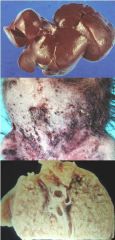
Organs from a Cushingoid dog. Explain the aetiology of each
|

|
|
|
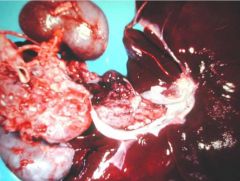
Dog: adrenal gland growth invading the hepatic artery. What's it likely to be?
|

Phaeochromocytoma (tumour of the adrenal medulla)
|
|
|
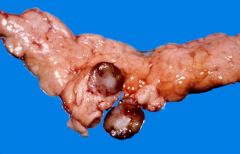
Pancreas of a dog showing episodic seuizures. What's it likely to be>
|

Insulinoma -> hypoglycaemia
|
|
|
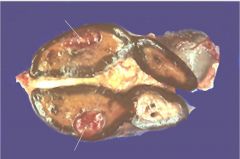
Ox adrenal. What's the arrow likely pointing to?
|

Phaeochromocytoma (tumour of the adrenal medulla)
|
|
|
|
Pix & Q from autotutorial start here
|
Pix & Q from autotutorial start here
|
|
|
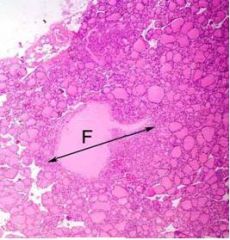
Thyroid from cat
What's the condition? Why is it different for a cat? What's the likely clinical signs? What's a likely sequelae? |

Nodular hyperplasia of the thryoid.
Often functional (hormonally active) in cats CS: weight loss, polyphagia, PUPD, anxiety, scruffy coat. In cats, can develop into functional adenomas. |
|
|
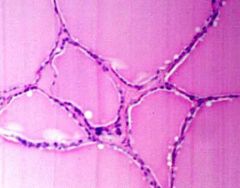
Lamb with bilateral large masses
Condition? 4 main causes |

colloidal goitre (involutary stage of diffuse hyperplastic goitre)
Goitre: I deficiency I excess Goitrogenic compounds Congenital dyshormonogenetic |
|

